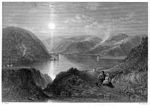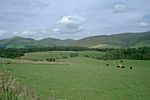Southern Upland Way

The Southern Upland Way is a 344-kilometre (214 mi) coast-to-coast long-distance footpath in southern Scotland. The route links Portpatrick in the west and Cockburnspath in the east via the hills of the Southern Uplands. The Way is designated as one of Scotland's Great Trails by NatureScot and is the longest of the 29 Great Trails. The Southern Upland Way meets with seven of the other Great Trails: the Annandale Way, the Berwickshire Coastal Path, the Borders Abbeys Way, the Cross Borders Drove Road, the Mull of Galloway Trail, the Romans and Reivers Route and St Cuthbert's Way.The path is maintained by the local authorities of the two main council areas through which it passes: Dumfries and Galloway Council and Scottish Borders Council; a short section in the Lowther Hills lies in South Lanarkshire. It is primarily intended for walkers, but many parts are suitable for mountain bikers; some sections are also suitable for horse riders. About 80,000 people use the path every year, of whom about 1,000 complete the entire route and a completion certificate can be applied for through the Southern Upland Way official website. It is considered the most difficult of Scotland's Great Trails but also one of the most rewarding to complete passing through some of the UK's most remote land. A popular and less challenging option is to walk it in two stages: typically Portpatrick to Moffat, then Moffat to Cockburnspath at a later date.
Excerpt from the Wikipedia article Southern Upland Way (License: CC BY-SA 3.0, Authors, Images).Southern Upland Way
Captains Road,
Geographical coordinates (GPS) Address Nearby Places Show on map
Geographical coordinates (GPS)
| Latitude | Longitude |
|---|---|
| N 55.466666666667 ° | E -3.2 ° |
Address
Captains Road
Captains Road
TD7 5LH
Scotland, United Kingdom
Open on Google Maps











